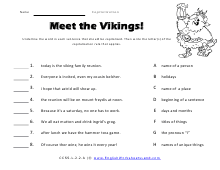Pronoun Worksheets
We never really think about it, but pronouns save us a great deal of time. They help make language more precise. They stop us from re-using the same old nouns. These are arranged in order of high frequency usage order. These worksheets help students understand the proper use and placement of pronouns in sentences.
These parts of speech really help us avoid repetition in language. When you first hear that, you might think to yourself that pronouns are pointless. Try writing a complete paragraph, better yet a story, without using a single pronoun and you will quickly she that it is hard to read and almost robotic, at times. There are many different types of words that serve this role. They can be used to show possession, ask a question, or even link phrases together. These worksheets will help students master the proper usage and placement of these wonderful parts of speech.
Capitalizing First Words and the Pronoun "I" - There are many different things that will be capitalized in your work, but these are the foundation of all the sentences that your will write.
I vs. Me - (I) can serve three different parts of speech based on the context. (me) serves the role of being an object pronoun.
Indefinite Forms - These do not refer to anything specific. They are like the free for all words.
Interrogative Forms - We use this to form questions and indicate they are often known as wh-words.
Personal, Possessive, and Indefinite Forms - This is a nice review of all the different forms that we need to explore.
Possessive Forms - We display ownership or sense of dominating control over with these words.
Relative Pronouns and Adverb - These help us form a relationship and over all ecosystem for our paragraph.
Reflexive Forms - These are characterized by words that end in -self or -selves.
Reflexive and Intensive Forms - These are instances where the subject and object are one in the same. Intensive forms are used to focus on the subject.
Plural Forms - These are the words that used to identify groups and collections.
Pronoun Shifts (Writing) - This is how to avoid this when composing sentences and paragraphs.
Reading With Shifts - We show you how to spot this over the course of the work.
Singular Forms - When we are focused on a single individual.
Subject Pronouns - These take the place of a noun that is the focus of the sentence.
Subject-Verb and Pronoun-Antecedent Agreement - We show you a technique to help you master this in your own writing.
Understanding Their Proper Use - When to use them and when to use the specific name we are talking about.
Using With Object - We show you the proper way to use them with objects in your sentences.
Working With Vague Pronouns - This is a proofreading skill. We show you how to identify them and make corrections.
Get FREE English Worksheets In Your Email
